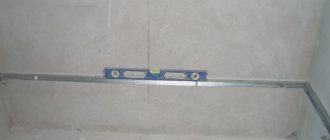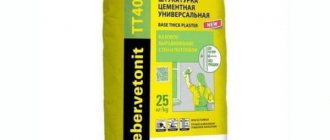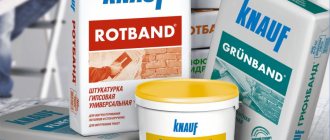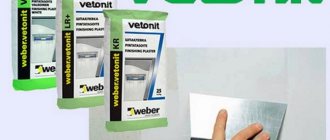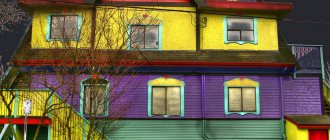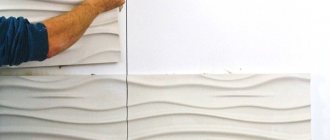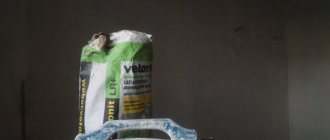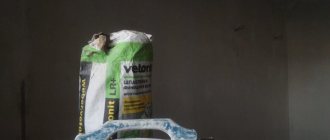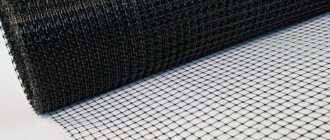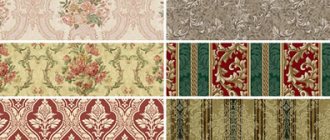Before starting finishing work on walls and ceilings, there is often a need to level them. For this, putty or putty is used. And one of its best manufacturers is the French company Weber, which has been firmly on the market for more than a hundred years. In this article we will talk about two products of this company - Vetonit KR and LR, as well as the differences between them.
As for the correct pronunciation - putty or putty, because both one and the other are often found - now these two words are considered equivalent, you can say both ways.
Working with putty is also called the finishing layer, because after leveling the surfaces, you can begin decorating them - painting, wallpapering, laying tiles, and so on. In some cases, if the work is done professionally with high-quality putty, the ceilings may no longer undergo any further processing.
No. 1. What are the advantages of the company's products?
The Weber company is considered the largest manufacturer of dry building mixtures in Europe, as evidenced by the fact that for several years in a row the brand's products have been leading in sales. The company was founded in 1900 and initially produced facade plasters in a Paris factory. In subsequent years, the range grew, sales markets expanded, but with the company's entry into the Saint-Gobain group in 1996, real international success came to it. Today, Weber-Vetonit dry building mixtures are sold in 49 countries and produced in 180 factories.
The brand has been officially represented in Russia since 2006. The company opened 3 factories in the country, which ensured the availability of all products for domestic buyers. Why did the manufacturer so captivate buyers around the world? The answer lies in several facts:
- the widest range of building mixtures , so finding a composition suitable for specific conditions will not be difficult;
- high quality of all products, introduction of innovations and use of modern equipment;
- all products undergo mandatory and voluntary safety testing ;
- product development based on consumer needs.
The quality has already been tested by millions of customers around the world. The main thing is to find the most suitable product and not get lost in the existing offer.
Methods for applying putty
To achieve the desired result in the finishing process, you need to follow the established procedure.
To properly mix the solution, you need to do the following:
- The components of the putty solution are prepared at an approximate calculation of 1.2 kg/m2 with a layer thickness of 1 mm. A bag weighing 25 kg uses about 8 liters of water.
- The contents of the bag are placed in water, the solution is stirred for about 10 minutes using an electric drill with an attachment; manually the consistency will be worse. The mixture settles for an average of 20 minutes and then beats again. The average shelf life of the mixed solution is about a day.
- For application, narrow (30 cm) and wide (70 cm) spatulas are used.
- The putty mixture is applied in one or two layers. With a two-layer treatment, the second layer is applied only to the completely dry first one.
- For priming, it is best to use an acrylic solution.
Puttying walls
The procedure includes the following steps:
- Preparation. Before applying the putty, the working surface is cleaned of small debris and old finishes. If there are minor defects on the surface, they must be eliminated with starting putty or plaster and then sanded to approximately the same level. Next, the surface is degreased.
- Padding. In order for the solution to adhere more firmly to the wall, it must be treated with a primer.
- Application. The solution is pulled out smoothly from side to side. The thickness of the applied layer is determined by the specific type of putty; each subsequent layer is applied after the previous one has dried. After the first layer has hardened, the surface can be sanded and then cleaned of construction dust. The coating is re-primed, then the final layer is drawn out.
- Finalization. When the finishing layer has dried, the surface is sanded, cleaned and primed, after which the wall is ready for further finishing work: wallpapering, painting.
Ceiling putty
The process has a specific algorithm:
- Preparation. The ceiling is cleaned of dirt and dust, the remains of the previous finish are removed, the surface is sanded and degreased.
- Padding. Like the wall, the ceiling is primed using a roller.
- Application. The putty is applied in small portions onto a large spatula and pulled out along the plane of the ceiling. At the end the surface is sanded.
No. 2. Plasters and putties Weber-Vetonit
The manufacturer's plasters are well suited for leveling the surfaces of walls and ceilings before subsequent puttying or decorative finishing. They are sold in the form of a dry mixture, which just needs to be diluted with water - all instructions are given on the packaging. The manufacturer's assortment includes the following compositions:
- gypsum white super-elastic plasters Easy Gyps (manual application only) and Profi Gyps (manual and mechanized application), which are versatile in use, but are not suitable for rooms with high humidity levels;
- white gypsum plaster Mech Gyps for manual and mechanized application, suitable for rooms with relatively normal humidity levels;
- moisture-resistant plaster TT40 is excellent for basic leveling of walls in bathrooms and other wet rooms, as well as for exterior work;
- cement moisture-resistant plaster is optimal when it is necessary to apply a thin layer of the composition;
- Facade Gray plaster is a new product from the company, a cement-based elastic composition that is characterized by its versatility of use and can be used when carrying out work in dry and wet rooms, as well as when repairing facades. Is different high strength and vapor permeability.
Putties are also available in the form of dry mixtures with the subsequent need to dissolve them with water:
- Weber Vetonit LR+ and Weber Vetonit LR+ silk polymer putties are used for final leveling of ceilings and walls before painting or wallpapering. Ready-made compounds can be applied to the surface without prior priming. The base can be concrete, plasterboard, cement or gypsum plaster. LR+ silk is a modified version of the LR+ series mixture. The product is super-plastic, allowing you to get perfectly even layers. When diluted, the mixture can remain suitable for application for a long time, and is characterized by an increased level of whiteness and ease of use. You can read more about the differences between the compositions and get acquainted with the company’s entire range of dry mixtures on the manufacturer’s website;
- putty with an organic binder KR is suitable for dry rooms and can be applied manually or mechanically;
- polymer putty is a unique product that contains microfiber. It has high adhesion to various materials, crack resistance and forms a perfectly smooth surface. It can be used to seal seams on drywall and even smooth out old painted surfaces . The JS Plus composition allows you to create a textured decorative surface, possessing the same properties;
- compositions VH and VH Gray - gypsum putties with moisture-resistant properties ;
- Facade White is a super white putty for interior and exterior use.
If you are in doubt about your choice, then convenient instructions and diagrams on the site mentioned above will help you make the right decision. To be sure of your choice, you can ask the company’s employees for advice.
Features of using putty
Instructions for applying finishing putty to walls begin with preparing the solution:
- To knead a 25-kilogram bag of the mixture, you will need 10 liters of water; the temperature of the liquid should not be higher than 40 degrees.
- The mixture is added to the water gradually; it is necessary to thoroughly mix the composition so that the mass is obtained without lumps. You can work more conveniently and quickly with a construction mixer.
- When the composition has been made to the desired consistency, it should sit for 10-15 minutes, after which it will require repeated mixing.
- The prepared solution can be used for 24 hours.
- Do not pour the solution down the drain; the product may clog them.
The mixture is added to the water gradually; it is necessary to thoroughly mix the composition so that the mass is obtained without lumps.
The preparatory stage includes the following actions:
- Clean the base from all types of contaminants, and, if necessary, degrease the wall;
- Areas that will not be puttied are covered in advance with film material or paper;
- It is necessary that the temperature in the room does not fall below +10 degrees.
The base is cleaned of all types of contaminants and, if necessary, the wall is degreased.
The composition should be applied as follows:
- The tool you can use is a sprayer or a double spatula; if the treatment area is small, then a regular spatula will do;
- When processing multi-layers, you will need to dry each layer completely;
- Excess mixture can be removed and reapplied;
- The next stage of finishing is carried out after drying; at temperatures of +20 degrees, you will need to wait a day if the layer does not exceed 1-2 mm;
- The dried base needs to be sanded with sandpaper, after which you can glue wallpaper or paint the walls;
- Tools used in repairing rollers and spatulas should be washed immediately after use.
To buy a high-quality solution, you need to request a certificate of quality and conformity from the seller.
When processing multi-layers, you will need to dry each layer completely.
Puttying the base with Vetonit KR mixture gives a high-quality result if the work is carried out according to the technology of use. The composition is used for rooms with moderate humidity; it creates a smooth white base, which is ideal for finishing walls or ceilings under any material, which increases the variety of applications.
No. 3. Floor mixtures
Walls and ceilings are not the only surfaces that need perfect leveling, which is why Weber-Vetonit has a lot of solutions for preparing floor surfaces:
- Floor levelers are cement-based mixtures that are suitable for quickly leveling the base for subsequent decorative finishing. Leveling mixtures can be used in rooms with any level of humidity, as well as with underfloor heating systems. The product provides minimal consumption and excellent performance. There are several different types of mixtures to choose from, which differ in the thickness of the leveling layer . With composition 4400, for example, you cannot make a layer more than 30 mm, and with composition 6000 you can make a layer up to 250 mm;
- self-leveling floors for residential and commercial premises. All compositions are suitable for use with “warm floors”, they are characterized by good spreadability, high speed of strength gain and low consumption. The manufacturer's assortment includes mixtures for self-leveling floors that can satisfy any need. For example, the fast-hardening Fast Level self-leveling floor provides maximum operating speed and a wide range of thicknesses (3-60 mm). Mix 4100 is highly durable, waterproof and crack resistant. There are also universal mixtures fiber-reinforced compounds (Strong), which are optimally suited for wooden floors and other complex substrates. The company also produces a mixture for soundproofing floors and a number of fine finishing leveling compounds;
- dry mixtures for arranging base and finishing coatings in production and industrial premises . The compositions perfectly withstand constant high loads and are wear-resistant. Among other things, the range includes decorative colored self-leveling floors .
We also note that the company produces auxiliary components for the installation of self-leveling floors.
Description and general features
There are various options for finishing putty to choose from: gypsum, cement, polymer, each of which is designed for specific purposes and operating conditions.
The characteristic qualities of Vetonit products include the following:
- The putty is made from natural ingredients.
- The composition spreads easily and stretches well over the surface.
- The powdery nature of the mixture provides a smooth and even surface.
- It is easy to sand.
- Improves the soundproofing qualities of the finished surface.
- Has low consumption.
- According to the release form:
- dry mixture;
- ready paste.
- Sold in durable three-layer bags weighing 5 and 25 kg.
No. 4. Adhesives and grouts
Ceramic tiles, one of the most popular finishing materials, have a lot of excellent performance qualities, but without good adhesive, all of them will be nullified. Weber-Vetonit produces high-quality adhesives for tiles, mosaics, stone and porcelain stoneware. The dry adhesive mixture can simply be mixed with the specified amount of water.
From the manufacturer’s assortment you can choose glue for any purpose:
- standard adhesives for interior and exterior use, characterized by good adhesion to various substrates;
- universal adhesives are presented in compositions for installing tiles, porcelain stoneware and stone on any base, suitable for use with “warm floors”. Separately, it is worth noting white mosaic glue , which provides not only excellent performance, but also high aesthetics;
- improved and special compounds are adhesives that have special properties and are suitable for use in difficult conditions. The manufacturer offers adhesives with improved frost resistance , as well as compositions that can be used when arranging swimming pools . There is also a composition that can be used with glass tiles.
The manufacturer also has suitable solutions for grouting joints These are colored cement grouts, which are suitable for joints of different thicknesses, as well as two-component epoxy-based grouts, which are ideal for further use in difficult conditions (high humidity, temperature changes).
Knauf
The products of this concern, as a cheap panacea for all construction problems, flooded the markets of domestic construction stores. After sand and clay, dry plaster mixtures from this company seemed to many to be the pinnacle of quality.
In fact, there is not much truth in these words. Knauf offers high-quality products and the technologies they have developed for their use. And it’s not the manufacturer’s fault that its recommendations are read one line at a time and are translated rather unreliably.
As for putties specifically, the brand offers several types at once.
KNAUF-Fugen
Enrolled in putties. On what grounds, however, is not entirely clear. Classic adhesive repair mixture. It was originally developed for sealing joints between plasterboard sheets. Later, they began to use it for gluing gypsum boards on walls (since the hardening time of Fugen is longer than that of Perlfix). Puttying walls with this mixture is a pleasure, to put it mildly. And there is no need to do this. For putty, the manufacturer has better and more suitable recipes.
- Price: 388 rub.
- Packing: 25 kg
KNAUF-Fugen GW
Also an adhesive repair mixture, which has a fibrous structure, is only intended for sealing gypsum fiber board joints. Again, it is of little use for putty.
- Price: 399 rub.
- Packing: 25 kg
KNAUF-Fugen-hydro
The same “Fugen”, only for moisture-resistant drywall, with all the ensuing consequences. True, the thickness of the applied layer was increased by the manufacturer from 3 to 5 mm.
The ductility is slightly higher than that of the classic Fugenfüller, but still there are few people willing to putty with such a mixture.
- Price: 1066 rub.
- Packing: 25 kg
KNAUF-Uniflot
And again glue. High-quality, high-strength, practically non-shrinking. Replaces any type of Fugen, and also surpasses it in technical indicators. But again, this is more of a repair mixture than putty in its pure form.
- Price 1197 rub.
- Packing: 25 kg
KNAUF-Rotband-Finish
Good putty. The manufacturer claims a reduced consumption of up to 20%, as well as a “lifetime” of the hammered mixture of up to one and a half hours. In fact, these figures are somewhat exaggerated, but there is still some sound evidence. In reality, you need to count on an hour of time, but this is more than enough to ensure that the solution does not go to waste.
- Price: 360 rub.
- Packing: 25 kg
KNAUF-Multi-Finish (gypsum)
Also a good putty for the money. The Knauf support service never told me what the fundamental difference between this mixture and Rotband-Finish is. In practice, Multifinish is easier to sand.
- Price: 366 rub.
- Packing: 25 kg
KNAUF-Multi-Finish M
Quite a good mixture for machine putty. However, no one will forbid putting putty with it even with an ordinary spatula. Moreover, the price for it is only slightly more than for a regular “Multi-Finish”.
- Price: 391 rub.
- Packing: 25 kg
KNAUF-HP Finish
Regular good quality finishing putty. One of the first that the then unspoiled Russian developer saw. Today, most more modern materials are superior to this mixture in quality, but habit is a great thing. Builders are a conservative people, they do not seek good from good, and therefore continue to use this mixture by inertia.
- Price 241 rub.
- Packing: 25 kg
KNAUF Multi-finish paste
The answer from Knauf, to various “shitroks”. Plastic, soft and ready-to-use mixture. At first glance, it differs from the same “Shitrok” in its more reasonable price, but this is not entirely true.
- Price: 650 rub.
- Packing: 20 kg
KNAUF Rotband-Paste
For the inexperienced buyer, it is not much different from the similar Multi-Finish paste. Well, except that the price turned out to be 60 rubles. higher.
- Price: 710 rub.
- Packing: 20 kg
KNAUF Multi-finish (cement)
We haven’t forgotten about cement mixtures. Cement-based plaster mixture has the same name as gypsum. So you need to be careful when purchasing. Unlike gypsum compositions, the cement recipe, to put it mildly, did not catch on. Although in vain, quite decent putty for the money. The plasticity, of course, is not the same as that of gypsum, but there’s nothing you can do about it - cement is cement.
- Price: 438 rub.
- Packing: 25 kg
No. 5. Dry mixtures for facade work
It is not for nothing that Weber-Vetonit is considered the largest manufacturer of dry construction mixtures - the company’s product range covers all possible repair and construction work. The manufacturer has prepared a range of products for the arrangement of facades:
- adhesive compositions for facade insulation systems , incl. for installation of expanded polystyrene, mineral wool. There are compositions that allow you to work at subzero temperatures, as well as mixtures that simultaneously allow you to create a base reinforced plaster layer. Certain compositions are suitable for thin-layer repairs of already plastered surfaces;
- facade plasters and putties allow you to create a perfectly flat and smooth surface, can be used in facade and interior work, allow you to create a layer up to 50 mm thick in one pass, and have good adhesion to different types of surfaces;
- decorative plasters and putties – high-quality and easy-to-apply compositions that can transform the facade of a house and can also be used in interior work. The range is represented by both ready-made formulations and dry mixtures. The latter are made on the basis of cement, are frost-resistant and vapor-permeable, and can be painted. There are compounds that can be applied at subzero temperatures.
How to calculate the required quantity
Vetonit KR putty will help get rid of the smallest surface defects. When choosing a product for construction work, an important parameter is the consumption rate. For the Kyrgyz Republic, the average level is 1.2 kilograms per square meter of area.
To understand how many packages to purchase, you need to measure the area of the room and multiply the result by this indicator. They take into account how many layers will be made, the resulting figure is also multiplied by the number of layers.
It is necessary to measure the area of the room, and multiply the result obtained by the average flow rate.
No. 6. What else does the company offer?
The manufacturer’s assortment can be described for a long time and cannot be fully described, since it is constantly updated. The company also produces waterproofing cement mixtures , as well as cement mixtures for repairing concrete, dry concrete for pouring into molds, mixtures for preparing non-shrinking compositions, mixtures for sealing interpanel joints. In addition, the manufacturer produces several types of repair compositions , as well as compositions for preparing masonry mortars (including colored compositions and compositions for work in winter). Another area of activity is fireproof solutions , which will be needed in the construction of stoves and fireplaces.
Finally, we note that the manufacturer’s products are of truly high quality, otherwise they would not have become so popular, and a guarantee of an excellent result is what is needed when it is necessary to carry out construction or repair work conscientiously. Small savings on building materials can bring disproportionately great disappointment in the near future and force you to redo all the work, again spending money on purchasing materials.
The article was written for the site.
Tags:Plastering works
Vetonit KR and LR
As can be seen from what is written above, there are few differences between these materials. The main one is the composition. The CR is made from organic materials, the LR is made from synthetic materials. It’s difficult to say which is better, but many note that when working with Vetonit KR, an unpleasant odor is observed.
Vetonit LR also has several varieties and you can more accurately select one of them for specific work, but KR can be purchased in a small five-kilogram package, which eliminates questions about how to store an opened package with the mixture so that it does not lose its properties.
Otherwise, the materials are identical, and when choosing one of them you need to rely on your own preferences and needs, and carefully read the information on the packaging before purchasing.
